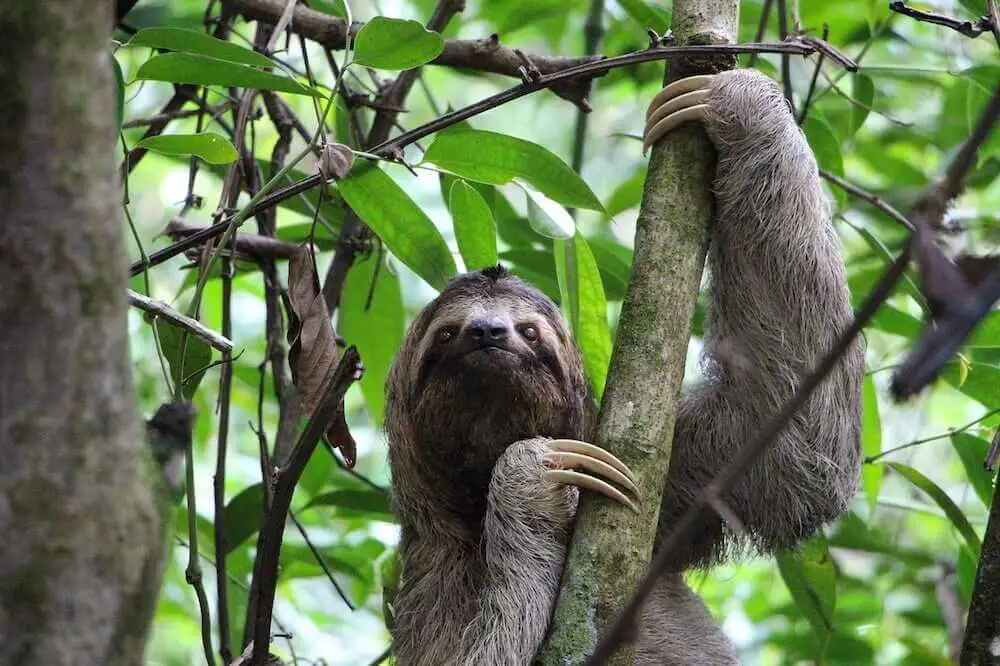
I guess not many people will be lucky enough to see a sloth up close. I visited an animal sanctuary while I was in Mexico some years ago and actually managed to see one. He wasn’t doing much apart from hanging around. What I didn’t realise at the time though was that there are actually several different types of sloths, rather than there just being one species.
So what are the different types of sloths and how many are there? There are 6 different types of sloths still living today. They are split between two genera, the two-toed and three-toed sloths. The 6 different species of sloths are Linnaeus’s two-toed sloth, Hoffmann’s two-toed sloth, maned sloth, pale-throated sloth, brown-throated sloth and pygmy sloth.
So there are 6 different types of sloths still living today. There are other sloth species that are now extinct that I haven’t gone into detail about in this article.
What you will find is some information about the two genera or categories of sloths, as well as more detail about each of the individual species of sloths. Read on to find out more!
Contents
Different Types Of Sloths
To understand the different types of sloths we first need to understand their place in the hierarchy of animals. In the classification of all living things, underneath mammals comes the ‘superorder’.
The superorder sits above an order of animals, whereas a suborder sits below this.
Sloths belong to the ‘superorder’ called Xenarthra. This is a collection of mammals that are native to The Americas. Within this superorder of Xenarthra, the extant (opposite to extinct) animals are sloths, anteaters and armadillos.
There are other extinct Xenarthrans that belong to this superorder such as glyptodonts, ground sloths and aquatic sloths! Underneath this super order of Xenarthra comes the order Pilosa.
Within this order there are anteaters and sloths. So anteaters are the most closely related animals to sloths! So the hierarchies so far are:
- Superorder – Xenartha
- Order – Pilosa
Within the order of Pilosa there are two distinct suborders. These are anteaters (Vermilingua) and sloths (Folivora). These suborders are then split into further families. Anteaters are split into two families, and sloths are also split into two extant families. These are Bradypodidae and Choloepodidae,
- Superorder – Xenartha
- Order – Pilosa
- Suborder – Folivora (sloths)
- Families:
- Bradypodidae
- Choloepodidae
We’re almost there. Underneath these families, comes the next classification, which is genera (the plural of genus). According to Wikipedia a genus is
a taxonomic rank used in the biological classification of living and fossil organisms, as well as viruses, in biology. In the hierarchy of biological classification, genus comes above species and below family.
So the families of sloths are broken down into a further two genera of sloths. These are Bradypus (three-toed sloths) and Choloepus (two-toed sloths). So now this goes:
- Superorder – Xenartha
- Order – Pilosa
- Suborder – Folivora (sloths)
- Family – Bradypodidae
- Genus – Bradypus
- Family – Choloepodidae
- Genus – Choloepus
These two genera of sloths are those known to still be extant today. There are several other genera of sloths that are extinct. The extant genera are split into a further 6 species or families, which I’ll go into some more detail about below.
The above is a fairly complex explanation. Believe me it took me several hours to get my head around it all. This is without me even going into detail about the extinct sloths!
What Is A Two-Toed Sloth?
The two-toed sloth, or to give it its genus name, Choloepus is the first of the genus of sloths we will look at in more detail.
The Choloepus is a member of the Choloepodidae family. The word Choloepus translates to ‘lame foot’ There are a further two sub-species in this genus. These are:
- Choloepus didactylus (Linnaeus’s two-toed sloth)
- Choloepus hoffmanni ( Hoffmann’s two-toed sloth)
It is funny that the major distinction between the two different genera of sloths comes down to how many toes they seem to have. In fact both of these types of sloths have 3 toes on their hind limbs.
It is only on their forelimbs where this differs. The two-toed sloth is so called because it has 2 toes on its front paws, and the three-toed has three on its front paws. The members of the two-toed sloth generally are bigger than their three-toed counterparts.
They grow to have a body length of between 58 and 70cm, and can weigh up to 8kg. They also differ from three-toed sloths in that they have a longer nose or snout, have much longer fur and do not have a tail (or at least a visible one).
Two-toed sloths are nocturnal creatures, and so spend almost the entire day sleeping. They do this by hanging upside down from trees. When climbing down from tress, two-toed sloths prefer to do this head first, which is the opposite of the way a three-toed sloth will do this.
Another interesting fact about the two-toed sloth genera is in the amount of vertebrae they have. These types of sloths only have 5 cervical vertebrae, whereas all other mammals have seven cervical vertebra, apart from the three-toed sloth and the manatee.
Two-toed sloths have great difficulty in walking. In fact, walking as we would define it is impossible for this type of sloth. Their extremely long finger nails make this very difficult.
Now we know that sloths are slow creatures anyway, but moving around on the ground for the two-toed sloth is even slower and more laborious than its three-toed counterpart. To do this a two-toed sloth has to pull one hand over the other to move around.
Two-toed sloths eat mostly leaves, fruits, nuts and berries but do also eat some small vertebrates. Sloths have an insanely slow metabolism, which explains why they move so slowly.
It is one of the features that have helped sloths adapt to the rainforest. Can you believe that it can take up to a month for them to digest food?
What Is A Three-Toed Sloth?
The three-toed sloth is the second of the genera of sloths we will look at before going into more detail about the different types of sloths within these genera. The genus name for the three-toed sloth is Bradypus, and it comes from the family Bradypodidae.
The major obvious difference between these and the two-toed sloth is that the three-toed sloth has three toes or fingers on its front limbs. The three-toed sloth can be further split into four different types of sloths, and these are:
- Bradypus torquatus (Maned sloth)
- Bradypus tridactylus (Pale-throated sloth)
- Bradypus variegatus (Brown-throated sloth)
- Bradypus pygmaeus (Pygmy three-toed sloth)
Three-toed sloths are generally quite a bit smaller than two-toed sloths. You could compare them to the size of a small dog, with the head and body measuring approximately 45cm in length.
These sloths spend almost all of their time hanging from trees high up in the canopy. Like two-toed sloths they have extremely slow metabolisms, and it can take up to a month for food to digest.
Interestingly enough, sloths only come down from the trees once a week to go to the toilet. As you can imagine for an animal that does not do anything quickly, coming down for this and then climbing back up is an arduous task.
This is also a dangerous time for a sloth. Their fur has a green appearance to it, and coupled with the fact that it is hanging in trees and does not move, it is usually well camouflaged. Coming down from this safety to be on the ground for any length of time puts them in harms way.
For an animal that can not move quickly at all, and cannot defend itself, being on the ground for any length of time makes them easy prey. In contrast to two-toed sloths, three-toed sloths are diurnal. This means that most of their awake time will be during the day, rather than at night.
Having said this, they still spend a large proportion of the day time sleeping too! Both two-toed and three-toed sloths are strong swimmers. Certainly in comparison to how well they can move on land that is.
They can swim approximately three times faster than they can move on land! In contrast to two-toed sloths, who only have five cervical vertebrae, three-toes sloths can have up to nine.
Most mammals tend to have seven. It is the addition of these extra two vertebrae that means that the three-toed sloth can turn its head almost 360 degrees.
So now that we know a little bit about the classification in terms of family and genera, let’s take a closer look at the different types of sloths still alive today.
What Are The 6 Different Types Of Sloths?
1. Linnaeus’s Two-Toed Sloth (Choloepus Didactylus)
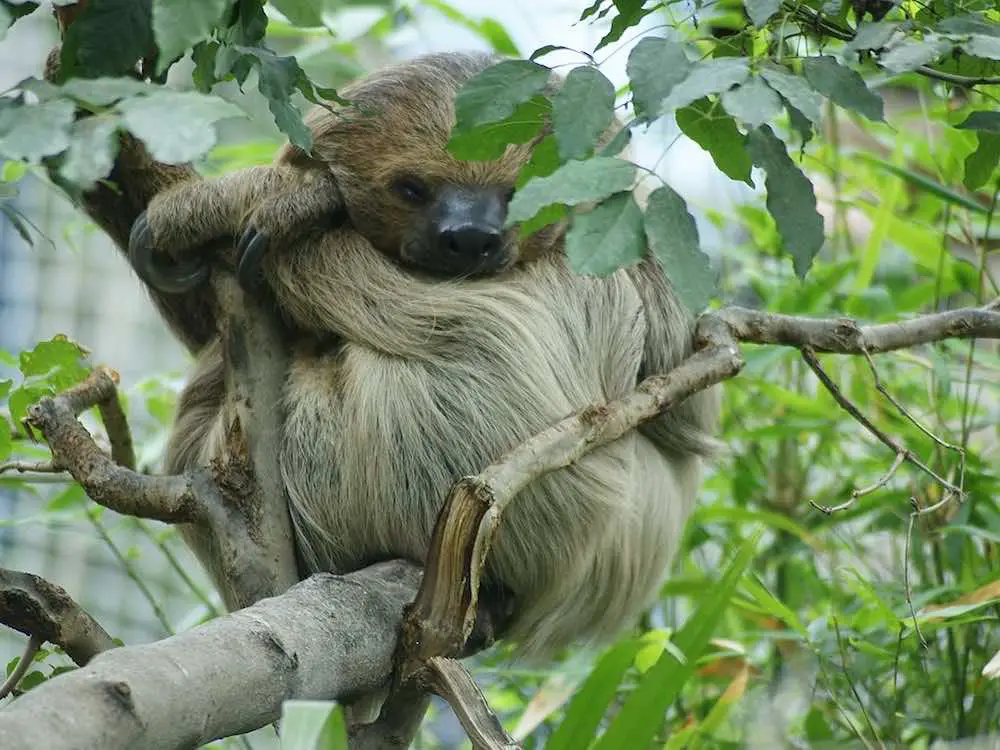
The Linnaeus’s sloth is the first of the different types of sloths from the two-toed sloth genus. The species name for this type of sloth is Choloepus didactylus. This type of sloth is also sometimes referred to as the southern two-toed sloth.
It is named after the person who discovered it, although I could not find much of anything about this person at all when I researched it! Linnaeus’s two-toed sloths are generally solitary creatures, choosing to spend most of their time alone.
They hang on trees and can sleep anywhere between 15 and 20 hours a day. An interesting fact about this type of sloth is the male to female ratio. For every one male Linnaeus’s two-toed sloth, there are 11 females.
Male sloths generally tend to hang (excuse the pun) alone, whereas female sloths can sometimes be seen in groups.
Where Does The Linnaeus’s Two-Toed Sloth Live?
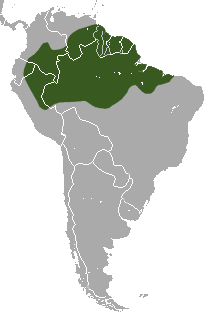
The Linnaeus’s two-toed sloth is native to South America, which is why it is sometimes referred to as the southern two-toed sloth. It lives in tropical and subtropical rainforests. You can find it in the following countries:
- Brazil
- Bolivia
- Columbia
- Ecuador
- The Guyanas
- Peru
What Does The Linnaeus’s Two-Toed Sloth Look Like?
The Linnaeus’s two-toed sloth has grey-brown or beige fur, although it will often have a greenish color to it. This is because it has algae growing in its fur.
Its fur is quite long in comparison to some other sloths, but it also has another layer underneath which is much shorter. The fur parts from the stomach and down towards its back.
This helps rain to run down from it during tropical rainstorms. This type of sloth is pretty tall as sloths go. It can reach a height of around 67cm. Interestingly it is also severely lacking in teeth.
It has only four to five sets, that include canines and molars. They do not have incisors. Their teeth are not coated in enamel like ours are.
What Does The Linnaeus’s Two-Toed Sloth Eat?
Its sad to say that the Linnaeus’s two-toed sloth does not exactly have the most adventurous diet. They are primarily herbivores, eating mostly leaves. They will also eat berries and fruits as well as any other vegetation they come across.
They will also sometimes eat small insects. Mostly its just leaves though sadly!
What Are The Biggest Threats To The Linnaeus’s Two-Toed Sloth?
Although they are slow creatures, and can be preyed upon by many animals., it is actually deforestation that is the biggest threat to this type of sloth. With more and more of the rainforests being cut down, there are less places for the Linnaeus’s two-toed sloth to live.
They can also be hit by cars that drive on roads through forests. These are roads that once upon a time would not have existed. Sloths are slow creatures, and it is hard or near impossible for them to move out of the way of oncoming cars.
With that being said, they are also classified as Least Concern on the IUCN Red List. Animals that will hunt this type of sloth include Jaguars and birds of prey.
2. Hoffmann’s Two-Toed Sloth (Choloepus Hoffmanni)
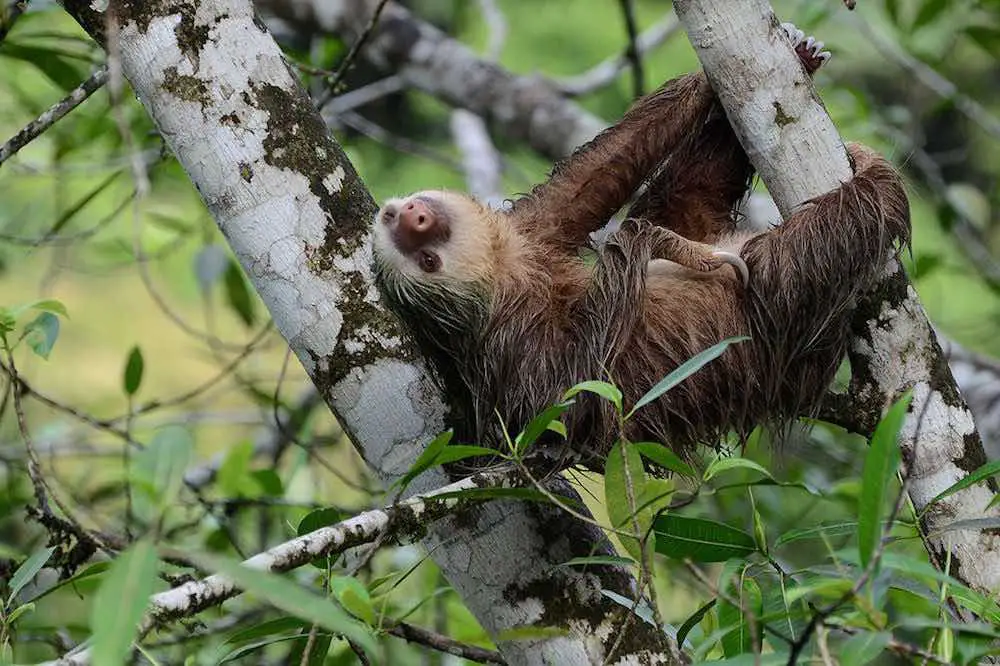
The second of the different types of sloths from the Choloepus genus is the Hoffmann’s two-toed sloth. This sloth is named so again after the person who discovered it. No sadly this is not the famous actor Dustin Hoffman, but instead the german naturalist Karl Hoffmann.
Hoffman also discovered a number of other species of animals, including Hoffmann’s woodpecker and Hoffmann’s earth snake. The Hoffmann’s two-toed sloth is a nocturnal sloth that spends almost all of its time hanging from trees.
This type of sloth also enjoys (or suffers) the same male to female ratio as mentioned above. There are five recognised subspecies of the Hoffman’s two-toed sloth, although they mostly tend to share many of the same characteristics in terms of appearance and behaviour. The five subspecies are:
- Choloepus hoffmanni hoffmanni
- Choloepus hoffmanni agustinus
- Choloepus hoffmanni capitalis
- Choloepus hoffmanni juruanus
- Choloepus hoffmanni pallescens
Where Does The Hoffmann’s Two-Toed Sloth Live?
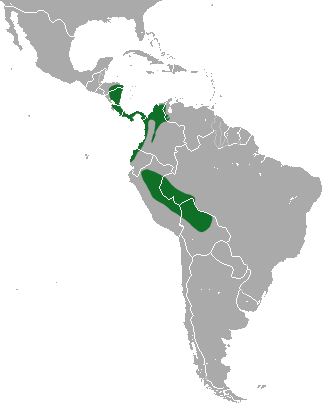
Like the previous types of sloth, this one also inhabits tropical rainforests, living in the canopies of these. It can be found in both Central and South America. You can expect to find these in:
- Bolivia
- Brazil
- Ecuador
- Honduras
- Peru
What Does The Hoffmann’s Two-Toed Sloth Look Like?
The Hoffmann’s two-toed sloth has long shaggy fur on its body, but less covering its face. It does look quite similar to the Linnaeus’s two-toed sloth, and you could be forgiven for mistaking the two.
A fully grown Hoffmann’s two-toed sloth will reach a height of between around 50cm and 70cm. Females do tend to be larger than males. Poor guys.
So more females that tend to be bigger than them. The males don’t stand a chance! The fur on their body is generally tan or light brown in color, but again can be discoloured by the presence of green algae.
What Does The Hoffmann’s Two-Toed Sloth Eat?
Although they can eat a number of things such as fruits and flowers, again this type of sloth generally tends to eat mostly leaves. They tear off leaves with their lips and then chew with teeth that have no enamel and are always growing.
They will fall out eventually, but don’t worry, they just grow new ones. Saves on the dental bill!
What Are The Biggest Threats To The Hoffmann’s Two-Toed Sloth?
Like most of the different types of sloths, habitat destruction poses probably the biggest threat the the Hoffmann’s two-toed sloth. In the wild there will be very little chance of a human actually running into one of these, but they are hunted and kept as exotic pets. Predators looking to eat the Hoffmann’s two-toed sloth include:
- Eagles
- Jaguars
- Large snakes such as anacondas.
3. Maned Sloth (Bradypus Torquatus)
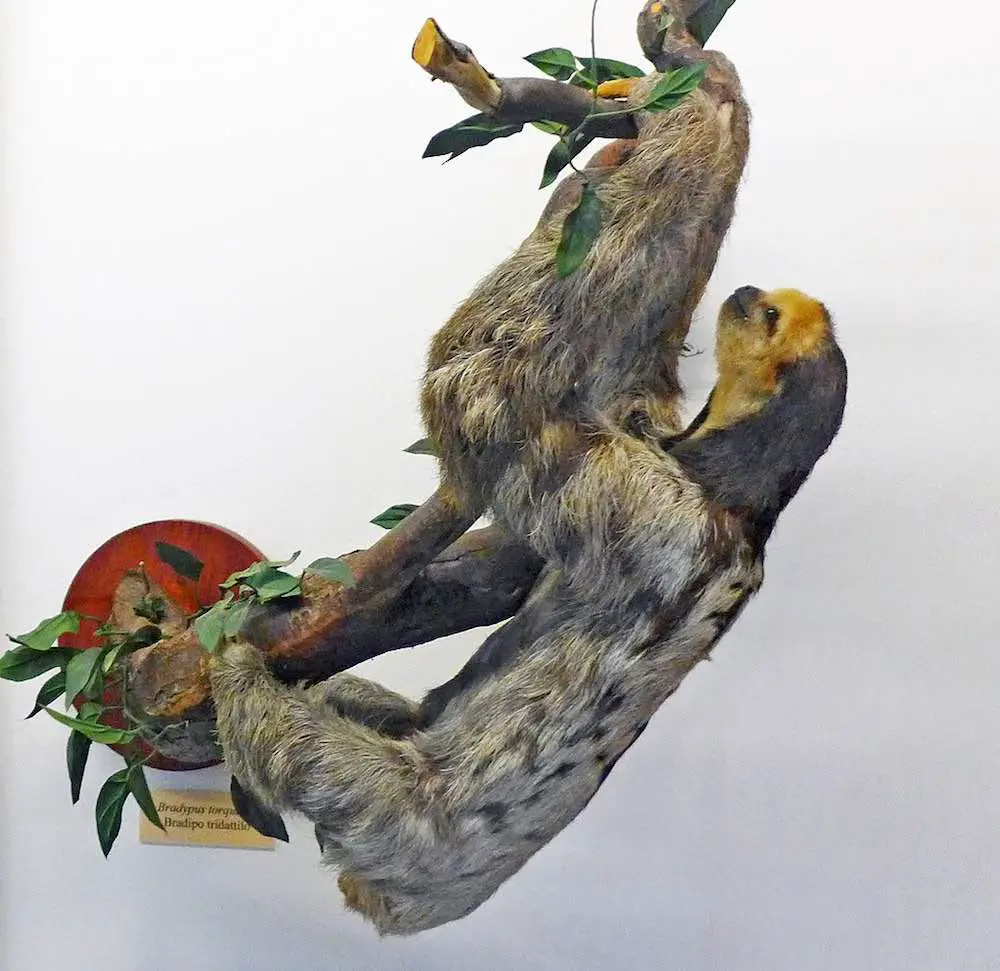
The maned sloth is the first of the different types of sloths from the Bradypus genus. Its species name is Bradypus torquatus. Like some of the other sloths on our list, the maned sloth is diurnal, meaning that it will be awake at some points during the day, and asleep at night.
However, this is probably a bit misleading as it can actually spend anywhere up to 19 or 20 hours in a 24 hour period sleeping! They will sleep in trees by hanging from branches by their hind legs and tucking their head in between their front legs.
Where Does The Maned Sloth Live?
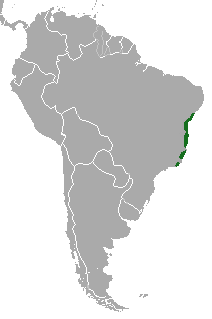
If you want to see this type of sloth in the wild I’m afraid there is only one place you can go to! The maned sloth is native only to Brazil. Although once found further North than this, the maned sloth resides only in the Atlantic Coastal rainforest of Southeastern Brazil.
The typical kind of climate the maned sloth is used to in this area is hot and humid, with a lot of rain. They don’t call it the rainforest for no reason I guess!
What Does The Maned Sloth Look Like?
The maned sloth generally tends to be pale brown in color. It has long fur which covers an underlying shorter black and white fur. The name maned sloth comes from the fact that it has a long mane of black hair running from its neck and covering its shoulders too.
The fur on the maned sloth actually grows in the opposite direction to that of most mammals. Due to the fact that they spend most of their time hanging upside down, this allows the large amount of rainwater to run down its body without getting caught up in the fur.
In terms of size, the maned sloth generally reaches somewhere in between 55cm and 70cm including its head and body. It is difficult to distinguish between the sexes, although as a general rule females tend to be bigger than males.
What Does The Maned Sloth Eat?
The maned sloth is primarily a herbivore. The vast majority of their diet, like most other sloths, is made up of leaves. They will also eat stems and bark, but this is more difficult for them to digest. Young leaves are the most ideal type of food for the maned sloth.
What Are The Biggest Threats To The Maned Sloth?
As I said above, the maned sloth is now only native to a specific part of Brazil. You used to be able to find this type of sloth further North, but due to deforestation they are now only native to one area.
As is the case with most sloths, human behavior is the biggest threat. Unfortunately their habitats have been cleared for wood, the making of charcoal and to be used for cattle to live. Sloths generally tend to be fairly well protected from predators.
This is because they hang high up in tress, blend in with their surroundings and barely move. There are however some animals that will hunt the maned sloth if they get the chance. These include:
- Jaguars
- Leopards
- Eagles
4. Pale-Throated Sloth (Bradypus Tridactylus)
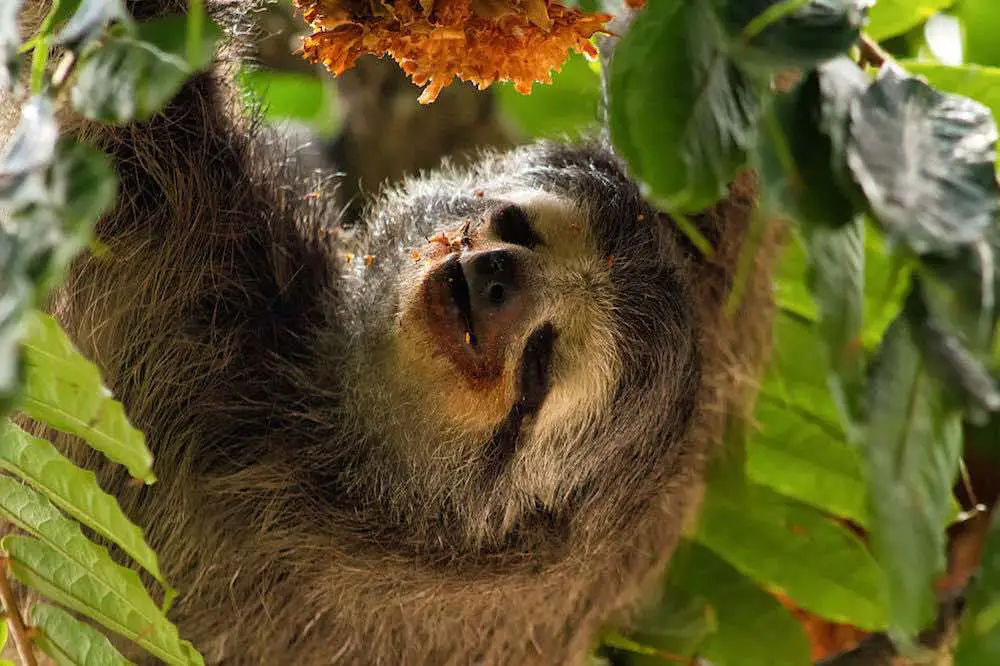
The second of the different types of sloths from the Bradypus genus is the pale-throated sloth (these sloths have such inventive names). The species name for this type of sloth is Bradypus tridactylus.
Although it is similar in appearance and clearly name, it should not be confused with the brown-throated sloth! The pale-throated sloth is, like many other sloths, a good swimmer.
Rather than moving about on land, if it wants to move between different areas of the rainforest it will swim in rivers as it can swim much quicker than it can move on land.
Where Does The Pale-Throated Sloth Live?
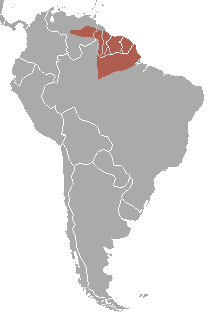
The pale-throated sloth is native to the rainforest of Northern South America. It can be found in the following countries:
- Brazil
- French Guiana
- Guyana
- Suriname
- Venezuela
Like the other types of sloths, the pale-throated sloth is a tree dweller. It has been found living in trees high up in mountains as well as in the rainforests.
What Does The Pale-Throated Sloth Look Like?
Fully grown pale-throated sloths are blackish grey in color with lighter and darker patches over most of their body. Males can grow to be as tall as 55cm, and females as tall as 75cm. Another of the different types of sloths where the female outweighs the male!
You can also distinguish between a male and a female by the patch of color on the males back. They have a bright yellow or orange patch on their back, which is split by a black stripe. The pale-throated sloth has a pale yellow patch on their throat, hence their name.
They have large eyes, but it is reported that they lack cone cells in the retina, leaving them unable to see in color. The pale-throated sloth also benefits from extra vertebrae, having nine instead of the usual seven in mammals. This means it is able to turn its head up to 330 degrees.
What Does The Pale-Throated Sloth Eat?
The pale-throated sloth appears to be pretty much entirely a folivore (an eater of leaves). Its diet consists mainly of leaves, and most of these come from Cecropia trees.
What Are The Biggest Threats To The Pale-Throated Sloth?
This type of sloth is listed as least concern. In the areas that it inhabits, there appear to be a great deal of them. However, as more and more of these areas are removed, the pale-throated sloth could be affected by this. Due to its specialised diet it does not survive well in captivity.
In its natural habitat there are a number of animals that prey on the pale-throated sloth. These include:
- Jaguars
- Ocelots
- Margays
- Eagles
- Big snakes such as anacondas
5. Brown-Throated Sloth (Bradypus Variegatus)
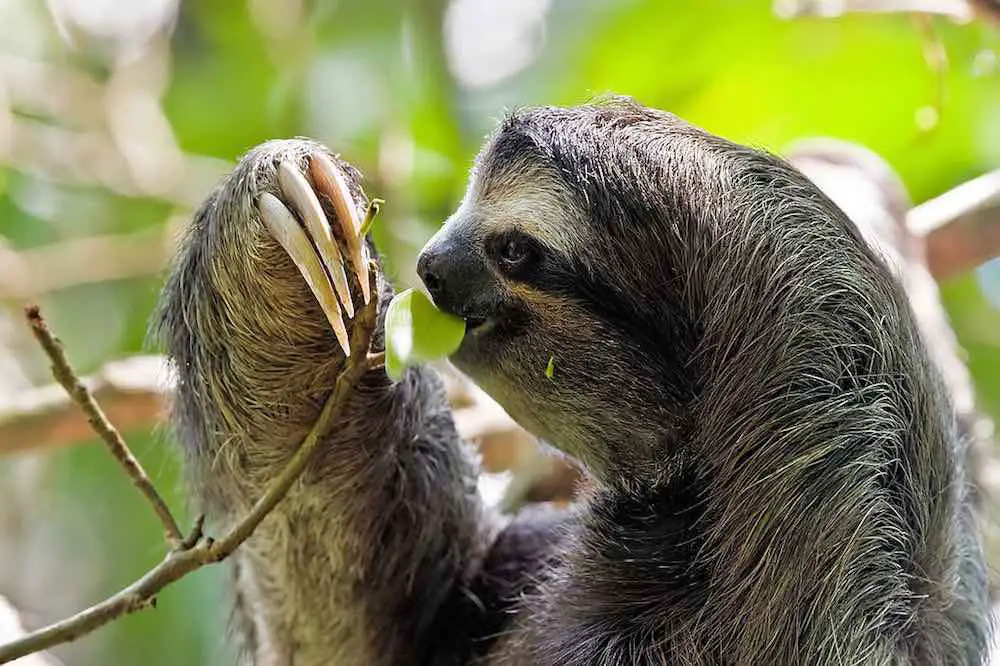
The brown-throated sloth (another inventive name) is the third of the different types of sloths from the Bradypus genus. Its species name is Bradypus variegatus, and the name brown-throated sloth, yes you guessed it, comes from the color of the fur on its throat.
The brown-throated sloth is the most common of the three-toed sloths, and can be found in a number of different environments. The brown-throated sloth was given its first description by Heinrich Rudolf Schinz, a physician and naturalist from Switzerland in 1825.
There are actually seven recognised subspecies of the brown throated sloth, although to the untrained human eye they will mostly appear to be the same. The seven subspecies are:
- Bradypus variegatus boliviensis
- Bradypus variegatus brasiliensis
- Bradypus variegatus ephippiger
- Bradypus variegatus gorgon
- Bradypus variegatus infuscatus
- Bradypus variegatus trivittatus
- Bradypus variegatus variegatus
Where Does The Brown-Throated Sloth Live?
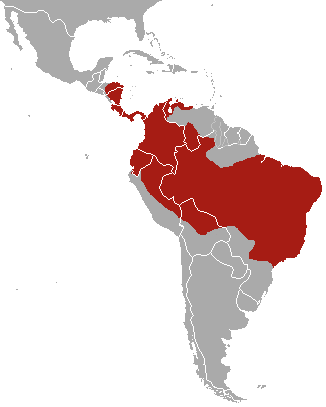
The brown-throated sloth can be found in Neotropical area of Central and South America. Like I said above, it is the most common of the different types of sloths, and as such can be found in a number of different countries. These are:
- Brazil
- Bolivia
- Columbia
- Costa Rica
- Ecuador
- Honduras
- Nicaragua
- Panama
- Peru
- Venezuela
It can be found in both evergreen and dry forests, and they have been sighted in areas of extremely high elevation. They usually live in the high canopies at the top of rainforests, only really coming down from here to use the toilet, which they do roughly once a week.
What Does The Brown-Throated Sloth Look Like?
You guessed it. The brown-throated sloth is distinguishable by the patch of brown fur on its throat. They are similar in appearance to the pale-throated sloth, and are most closely related to this type of sloth. The patch is the most distinguishable feature between the two.
They have an under layer of short soft fur, and an outer layer of much longer fur. The fur is usually brownish grey in color, and the fur on the throat, sides of the face and forehead are darker. The centre of the face is usually pale, with a dark stripe of fur between the eyes.
The size of this sloth is generally similar to the others we have looked at, but this time there appears to be no difference in size between the sexes. Height can range from approximately 40cm to 80cm.
The brown-throated sloth also benefits from extra vertebrate, having roughly nine instead of the usual 7 in mammals. Again this means it can rotate its head much more than a regular mammal can.
What Does The Brown-Throated Sloth Eat?
The brown-throated sloth is a herbivore, and like the pale-throated sloth, takes most or all of its food from a number of different types of trees. It will eat mostly leaves, but can also eat flowers and fruits too. Most of its water will be take from leaves, although they have been observed drinking from rivers too.
What Are The Biggest Threats To The Brown-Throated Sloth?
Like the pale-throated sloth, this type of sloth is rated by the IUCN as least concern in its Red List of Threatened Species. In the areas they live in, there appear to be a high number of them in existence.
The most dangerous time for this sloth, just like most of the other different types of sloths on the list, is when it descends from the trees to use the toilet. At this time they are most vulnerable to predators. Animals that can prey on the brown-throated sloth include:
- Jaguars
- Spectacled owls
- Harpy eagles
6. Pygmy Three-Toed sloth (Bradypus pygmaeus)
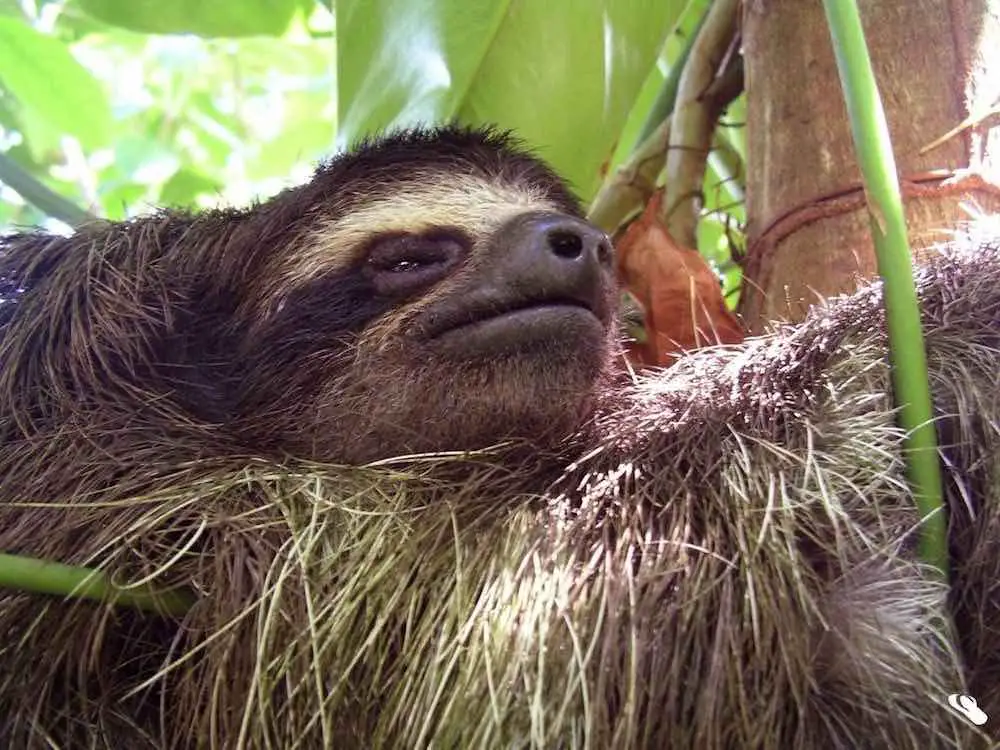
So onto the last of our different types of sloths. This one is the pygmy-three toed sloth, the last on our list from the bradypus genus. The species name for this type of sloth is Bradypus pygmaues, obviously translating to three-toed pygmy sloth.
This type of sloth can also be referred to as the monk sloth and the dwarf sloth. As the name would suggest, this is a small sloth, much smaller than some of the other different types of sloths on the list.
It appears to have been first described by Robert P. Anderson, a professor of biology, and Charles O. Handley Jr. of the Smithsonian Institution in 2001.
Where Does The Pygmy Three-Toed Sloth Live?
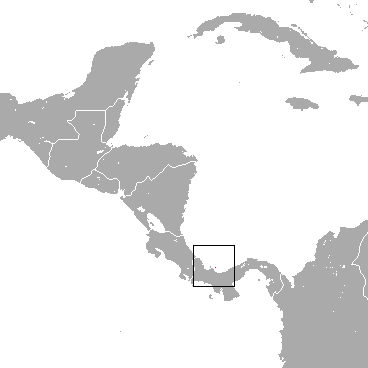
The pygmy three-toed sloth is much rarer than some of the other species of sloths we have looked at. It inhabits a very specific region, rather than being spread out over a number of different countries.
It is native to a small island just off the coast of Panama, knows as Isla Escudo de Veraguas. Within this Island, the pygmy three-toed sloth resides specifically in the red mangroves that can be found there. This is a very small area, approximately 4.3 square kilometres in size.
What Does The Pygmy Three-Toed Sloth Look Like?
Like I said, the pygmy three-toed sloth is smaller in size than many of the other types of sloths on this list. Combined head and body length reaches no more than around 50cm altogether. It is quite similar in looks to the brown-throated sloth.
They have a light brownish-yellow colored fur, and dark patches or circles around their eyes. The rest of the fur on their face is an orange color. Their throat is a brownish grey color, making it resemble the brown-throated sloth in appearance.
What Does The Pygmy Three-Toed Sloth Eat?
The pygmy three-toed sloth is described as a herbivore, and often more specifically as a folivore. This is because it primarily eats the leaves from a number of different trees. It will take most of its water from the leaves it eats, and like the other sloths, has an extremely slow metabolic rate.
What Are The Biggest Threats To The Pygmy Three-Toed Sloth?
Sadly the pygmy three-toed sloth is in great danger of becoming extinct. They have been listed by the IUCN as critically endangered. Due to the fact that they live in an extremely small area, and the fact that they are illegally hunted, there are very few left in existence.
There appears to be a population of less than 100, which is tiny, and doesn’t bode well for the continued existence of this type of sloth.
Summing Up
So that’s it. There are 6 different types of sloths split between two larger categories, the two-toed and the three-toed sloth. Whilst there are some similarities between them, there are some differences too, both in terms of appearance and also in habitat.
Some are rated as in great danger of becoming extinct, and others are rated as not being of such concern. As more and more of the areas that these sloths live in come under threat, we will see over the coming years that more of the different types of sloths will become endangered too.
If you would like to add anything to this article, or have any questions, please feel free to leave a comment below Thanks for reading.

